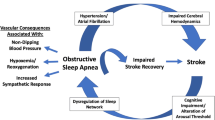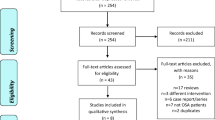Abstract
Background
Low arousal threshold plays a part in the pathogenesis of obstructive sleep apnea (OSA) and may be improved by sedatives. Sedative antidepressants are frequently prescribed for stroke patients due to their high prevalence of insomnia and depression. However, the effect of sedative antidepressants on the severity of OSA in stroke patients has not been studied well.
Methods
In a double-blinded randomized crossover pilot study, 22 post-acute ischemic stroke patients (mean age, 61.7 ± 10.6 y) with OSA received 100 mg of trazodone or a placebo just before polysomnography, with approximately 1 week between measures. The study also measured baseline heart rate variability and 24-h ambulatory blood pressure.
Results
Administration of trazodone significantly increased the percentage time of slow-wave sleep (31.5 ± 13.2 vs. 18.4 ± 8.7%; P < 0.001) and improved almost all the parameters of OSA severity, including the apnea–hypopnea index (AHI, 25.4 ± 15.4 vs. 39.1 ± 18.4 events/h; P < 0.001), the respiratory arousal index (9.8 (5.8–11.95) vs. 14.1 (11.3–18.7) events/h; P < 0.001), and the minimum oxygen saturation (80.2 ± 9.1 vs. 77.1 ± 9.6%; P = 0.016). Responders to therapy (AHI reduced by > 50%; n = 7/22) had predominant OSA during rapid-eye-movement sleep and decreased sympathetic tone, as reflected in significantly lower mean blood pressure, diastolic blood pressure, and normalized low-frequency power.
Conclusions
Obstructive sleep apnea with comorbid ischemic stroke may be a distinctive phenotype which responds quite well to trazodone, decreasing OSA severity without increasing nocturnal hypoxia.
Trial Registration
Clinicaltrials.gov: NCT04162743, 2019/11/10.


Similar content being viewed by others
Data availability
The data that support the findings of this study are available from the corresponding author upon reasonable request.
References
Eckert DJ, White DP, Jordan AS, Malhotra A, Wellman A (2013) Defining phenotypic causes of obstructive sleep apnea. Identification of novel therapeutic targets. Am J Respir Crit Care Med 188(8):996–1004. https://doi.org/10.1164/rccm.201303-0448OC
Thomas RJ (2003) Arousals in sleep-disordered breathing: patterns and implications. Sleep 26(8):1042–1047
Rees K, Spence DP, Earis JE, Calverley PM (1995) Arousal responses from apneic events during non-rapid-eye-movement sleep. Am J Respir Crit Care Med 152(3):1016–1021. https://doi.org/10.1164/ajrccm.152.3.7663777
Younes M (2004) Role of arousals in the pathogenesis of obstructive sleep apnea. Am J Respir Crit Care Med 169(5):623–633. https://doi.org/10.1164/rccm.200307-1023OC
Eckert DJ (1985) Younes MK (2014) Arousal from sleep: implications for obstructive sleep apnea pathogenesis and treatment. J Appl Physiol 116(3):302–313. https://doi.org/10.1152/japplphysiol.00649.2013
Eckert DJ, Owens RL, Kehlmann GB, Wellman A, Rahangdale S, Yim-Yeh S, White DP, Malhotra A (2011) Eszopiclone increases the respiratory arousal threshold and lowers the apnoea/hypopnoea index in obstructive sleep apnoea patients with a low arousal threshold. Clin Sci 120(12):505–514. https://doi.org/10.1042/cs20100588
Ratnavadivel R, Stadler D, Windler S, Bradley J, Paul D, McEvoy RD, Catcheside PG (2010) Upper airway function and arousability to ventilatory challenge in slow wave versus stage 2 sleep in obstructive sleep apnoea. Thorax 65(2):107–112. https://doi.org/10.1136/thx.2008.112953
Wains SA, El-Chami M, Lin H-S, Mateika JH (2017) Impact of arousal threshold and respiratory effort on the duration of breathing events across sleep stage and time of night. Respir Physiol Neurobiol 237:35–41. https://doi.org/10.1016/j.resp.2016.12.009
Gray EL, McKenzie DK, Eckert DJ (2017) Obstructive sleep apnea without obesity is common and difficult to treat: evidence for a distinct pathophysiological phenotype. J Clin Sleep Med 13(1):81–88. https://doi.org/10.5664/jcsm.6394
Edwards BA, Eckert DJ, McSharry DG, Sands SA, Desai A, Kehlmann G, Bakker JP, Genta PR, Owens RL, White DP, Wellman A, Malhotra A (2014) Clinical predictors of the respiratory arousal threshold in patients with obstructive sleep apnea. Am J Respir Crit Care Med 190(11):1293–1300. https://doi.org/10.1164/rccm.201404-0718OC
Berry RB, Kouchi K, Bower J, Prosise G, Light RW (1995) Triazolam in patients with obstructive sleep apnea. Am J Respir Crit Care Med 151(2):450–454
Hoijer U, Hedner J, Ejnell H, Grunstein R, Odelberg E, Elam M (1994) Nitrazepam in patients with sleep apnoea: a double-blind placebo-controlled study. Eur Respir J 7(11):2011–2015
Carter SG, Berger MS, Carberry JC, Bilston LE, Butler JE, Tong BKY, Martins RT, Fisher LP, McKenzie DK, Grunstein RR, Eckert DJ (2016) Zopiclone increases the arousal threshold without impairing genioglossus activity in obstructive sleep apnea. Sleep 39(4):757–766. https://doi.org/10.5665/sleep.5622
Carberry JC, Grunstein RR, Eckert DJ (2019) The effects of zolpidem in obstructive sleep apnea—an open-label pilot study. J Sleep Res 28(6):e12853. https://doi.org/10.1111/jsr.12853
Brunner H (2008) Success and failure of mirtazapine as alternative treatment in elderly stroke patients with sleep apnea-a preliminary open trial. Sleep Breath 12(3):281–285
Eckert DJ, Malhotra A, Wellman A, White DP (2014) Trazodone increases the respiratory arousal threshold in patients with obstructive sleep apnea and a low arousal threshold. Sleep 37(4):811–819. https://doi.org/10.5665/sleep.3596
Smales ET, Edwards BA, Deyoung PN, McSharry DG, Wellman A, Velasquez A, Owens R, Orr JE, Malhotra A (2015) Trazodone effects on obstructive sleep apnea and non-REM arousal threshold. Ann Am Thorac Soc 12(5):758–764. https://doi.org/10.1513/AnnalsATS.201408-399OC
Leppävuori A, Pohjasvaara T, Vataja R, Kaste M, Erkinjuntti T (2002) Insomnia in ischemic stroke patients. Cerebrovasc Dis 14(2):90–97
Farner L, Wagle J, Engedal K, Flekkøy KM, Wyller TB, Fure B (2010) Depressive symptoms in stroke patients: a 13 month follow-up study of patients referred to a rehabilitation unit. J Affect Disord 127(1–3):211–218. https://doi.org/10.1016/j.jad.2010.05.025
Lyons OD, Ryan CM (2015) Sleep apnea and stroke. Can J Cardiol 31(7):918–927
Schutte-Rodin S, Broch L, Buysse D, Dorsey C, Sateia M (2008) Clinical guideline for the evaluation and management of chronic insomnia in adults. J Clin Sleep Med 4(5):487–504
Shah S, Vanclay F, Cooper B (1989) Improving the sensitivity of the Barthel Index for stroke rehabilitation. J Clin Epidemiol 42(8):703–709. https://doi.org/10.1016/0895-4356(89)90065-6
Johns MW (1991) A new method for measuring daytime sleepiness: the Epworth sleepiness scale. Sleep 14(6):540–545
de Man-van GJ, Hafsteinsdottir TRNPD, Lindeman EMDPD, Burger HMDPD, Grobbee DMDPD, Schuurmans MRNPD (2012) An efficient way to detect poststroke depression by subsequent administration of a 9-item and a 2-item patient health questionnaire. Stroke 43(3):854–856
Wallace DM, Wohlgemuth WK (2019) Predictors of insomnia severity index profiles in United States veterans with obstructive sleep apnea. J Clin Sleep Med 15(12):1827–1837. https://doi.org/10.5664/jcsm.8094
Berry R, Brooks R, Gamaldo C (2014) The AASM manual for the scoring of sleep and associated events: rules, terminology and technical specifications, Version 2.0.3. American Academy of Sleep Medicine, Darien, IL
Burr RL (2007) Interpretation of normalized spectral heart rate variability indices in sleep research: a critical review. Sleep 30(7):913
Yu C-C, Huang C-Y, Kuo W-K, Chen C-Y (2019) Continuous positive airway pressure improves nocturnal polyuria in ischemic stroke patients with obstructive sleep apnea. Clin Interv Aging 14:241–247. https://doi.org/10.2147/CIA.S193448
Rowat AM, Wardlaw JM, Dennis MS, Warlow CP (2001) Patient positioning influences oxygen saturation in the acute phase of stroke. Cerebrovasc Dis 12(1):66–72. https://doi.org/10.1159/000047683
Ramar K, Dort LC, Katz SG, Lettieri CJ, Harrod CG, Thomas SM, Chervin RD (2015) Clinical practice guideline for the treatment of obstructive sleep apnea and snoring with oral appliance therapy: an update for 2015. J Clin Sleep Med 11(7):773–827. https://doi.org/10.5664/jcsm.4858
Bassetti CLA, Randerath W, Vignatelli L, Ferini-Strambi L, Brill AK, Bonsignore MR, Grote L, Jennum P, Leys D, Minnerup J, Nobili L, Tonia T, Morgan R, Kerry J, Riha R, McNicholas WT, Papavasileiou V (2020) EAN/ERS/ESO/ESRS statement on the impact of sleep disorders on risk and outcome of stroke. Eur Respir J 55(4):1901104. https://doi.org/10.1183/13993003.01104-2019
Mello-Fujita L, Kim LJ, Palombini LdO, Rizzi C, Tufik S, Andersen ML, Coelho FM (2015) Treatment of obstructive sleep apnea syndrome associated with stroke. Sleep Med 16(6):691–696. https://doi.org/10.1016/j.sleep.2014.12.017
Edwards BA, O’Driscoll DM, Ali A, Jordan AS, Trinder J, Malhotra A (2010) Aging and sleep: physiology and pathophysiology. Semin Respir Crit Care Med 31(5):618–633. https://doi.org/10.1055/s-0030-1265902
Guyenet PG, Abbott SBG (2013) Chemoreception and asphyxia-induced arousal. Respir Physiol Neurobiol 188(3):333–343. https://doi.org/10.1016/j.resp.2013.04.011
Mendelson WB (2005) A review of the evidence for the efficacy and safety of trazodone in insomnia. J Clin Psychiatry 66(4):469–476
Subramanian S, Hesselbacher S, Mattewal A, Surani S (2013) Gender and age influence the effects of slow-wave sleep on respiration in patients with obstructive sleep apnea. Sleep Breath 17(1):51–56. https://doi.org/10.1007/s11325-011-0644-4
Veasey SC (2003) Serotonin agonists and antagonists in obstructive sleep apnea. Am J Respir Med 2(1):21–29. https://doi.org/10.1007/BF03256636
Messineo L, Eckert DJ, Lim R, Chiang A, Azarbarzin A, Carter SG, Carberry JC (2020) Zolpidem increases sleep efficiency and the respiratory arousal threshold without changing sleep apnoea severity and pharyngeal muscle activity. J Physiol 598(20):4681–4692. https://doi.org/10.1113/JP280173
Berry RB, Gleeson K (1997) Respiratory arousal from sleep: mechanisms and significance. Sleep 20(8):654–675
Basoglu OK, Tasbakan MS (2018) Gender differences in clinical and polysomnographic features of obstructive sleep apnea: a clinical study of 2827 patients. Sleep Breath 22(1):241–249
Samuels ER, Szabadi E (2008) Functional neuroanatomy of the noradrenergic locus coeruleus: its roles in the regulation of arousal and autonomic function part II: physiological and pharmacological manipulations and pathological alterations of locus coeruleus activity in humans. Curr Neuropharmacol 6(3):254–285. https://doi.org/10.2174/157015908785777193
Funding
Study funded by the Chang Gung Medical Research Council under Contract No. CMRPG2I0021.
Author information
Authors and Affiliations
Corresponding author
Ethics declarations
Conflicts of interest
On behalf of all authors, the corresponding author states that there is no conflict of interest.
Ethical approval
The study was conducted in accordance with the Declaration of Helsinki and approved by the Institutional Review Board of Chang Gung Medical Foundation.
Informed consent to participate
Informed consent was obtained from all participants and/or their legal guardians.
Informed consent for publication
Patients signed informed consent regarding publishing their data and photographs.
Rights and permissions
About this article
Cite this article
Chen, CY., Chen, CL. & Yu, CC. Trazodone improves obstructive sleep apnea after ischemic stroke: a randomized, double-blind, placebo-controlled, crossover pilot study. J Neurol 268, 2951–2960 (2021). https://doi.org/10.1007/s00415-021-10480-2
Received:
Revised:
Accepted:
Published:
Issue Date:
DOI: https://doi.org/10.1007/s00415-021-10480-2




